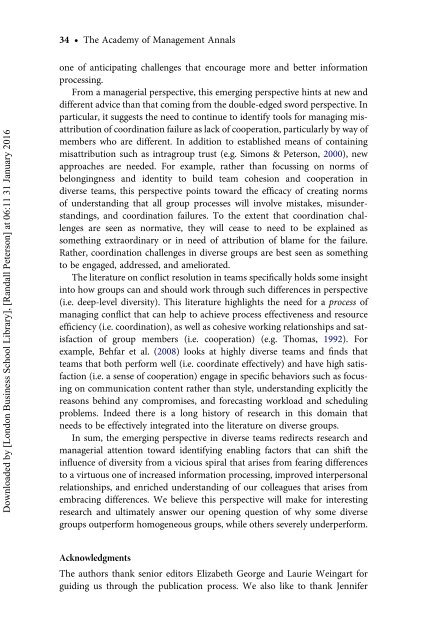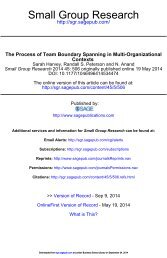A Dynamic Perspective on Diverse Teams: Moving From The Dual Process Model to A Dynamic Coordination-Based Model of Diverse Team Performance - Kannan Srikanth, Sarah Harvey & Randall Peterson
The existing literature on diverse teams suggests that diversity is both helpful to teams in making more information available and encouraging creativity and damaging to teams in reducing cohesion and information sharing. Thus the extant literature suggests that diversity within teams is a double-edged sword that leads to both positive and negative effects simultaneously.
The existing literature on diverse teams suggests that diversity is both helpful to teams in making more information available and encouraging creativity and
damaging to teams in reducing cohesion and information sharing. Thus the
extant literature suggests that diversity within teams is a double-edged sword
that leads to both positive and negative effects simultaneously.
Create successful ePaper yourself
Turn your PDF publications into a flip-book with our unique Google optimized e-Paper software.
34 † <strong>The</strong> Academy <strong>of</strong> Management Annals<br />
Downloaded by [L<strong>on</strong>d<strong>on</strong> Business School Library], [<strong>Randall</strong> Peters<strong>on</strong>] at 06:11 31 January 2016<br />
<strong>on</strong>e <strong>of</strong> anticipating challenges that encourage more and better informati<strong>on</strong><br />
processing.<br />
<strong>From</strong> a managerial perspective, this emerging perspective hints at new and<br />
different advice than that coming from the double-edged sword perspective. In<br />
particular, it suggests the need <strong>to</strong> c<strong>on</strong>tinue <strong>to</strong> identify <strong>to</strong>ols for managing misattributi<strong>on</strong><br />
<strong>of</strong> coordinati<strong>on</strong> failure as lack <strong>of</strong> cooperati<strong>on</strong>, particularly by way <strong>of</strong><br />
members who are different. In additi<strong>on</strong> <strong>to</strong> established means <strong>of</strong> c<strong>on</strong>taining<br />
misattributi<strong>on</strong> such as intragroup trust (e.g. Sim<strong>on</strong>s & Peters<strong>on</strong>, 2000), new<br />
approaches are needed. For example, rather than focussing <strong>on</strong> norms <strong>of</strong><br />
bel<strong>on</strong>gingness and identity <strong>to</strong> build team cohesi<strong>on</strong> and cooperati<strong>on</strong> in<br />
diverse teams, this perspective points <strong>to</strong>ward the efficacy <strong>of</strong> creating norms<br />
<strong>of</strong> understanding that all group processes will involve mistakes, misunderstandings,<br />
and coordinati<strong>on</strong> failures. To the extent that coordinati<strong>on</strong> challenges<br />
are seen as normative, they will cease <strong>to</strong> need <strong>to</strong> be explained as<br />
something extraordinary or in need <strong>of</strong> attributi<strong>on</strong> <strong>of</strong> blame for the failure.<br />
Rather, coordinati<strong>on</strong> challenges in diverse groups are best seen as something<br />
<strong>to</strong> be engaged, addressed, and ameliorated.<br />
<strong>The</strong> literature <strong>on</strong> c<strong>on</strong>flict resoluti<strong>on</strong> in teams specifically holds some insight<br />
in<strong>to</strong> how groups can and should work through such differences in perspective<br />
(i.e. deep-level diversity). This literature highlights the need for a process <strong>of</strong><br />
managing c<strong>on</strong>flict that can help <strong>to</strong> achieve process effectiveness and resource<br />
efficiency (i.e. coordinati<strong>on</strong>), as well as cohesive working relati<strong>on</strong>ships and satisfacti<strong>on</strong><br />
<strong>of</strong> group members (i.e. cooperati<strong>on</strong>) (e.g. Thomas, 1992). For<br />
example, Behfar et al. (2008) looks at highly diverse teams and finds that<br />
teams that both perform well (i.e. coordinate effectively) and have high satisfacti<strong>on</strong><br />
(i.e. a sense <strong>of</strong> cooperati<strong>on</strong>) engage in specific behaviors such as focusing<br />
<strong>on</strong> communicati<strong>on</strong> c<strong>on</strong>tent rather than style, understanding explicitly the<br />
reas<strong>on</strong>s behind any compromises, and forecasting workload and scheduling<br />
problems. Indeed there is a l<strong>on</strong>g his<strong>to</strong>ry <strong>of</strong> research in this domain that<br />
needs <strong>to</strong> be effectively integrated in<strong>to</strong> the literature <strong>on</strong> diverse groups.<br />
In sum, the emerging perspective in diverse teams redirects research and<br />
managerial attenti<strong>on</strong> <strong>to</strong>ward identifying enabling fac<strong>to</strong>rs that can shift the<br />
influence <strong>of</strong> diversity from a vicious spiral that arises from fearing differences<br />
<strong>to</strong> a virtuous <strong>on</strong>e <strong>of</strong> increased informati<strong>on</strong> processing, improved interpers<strong>on</strong>al<br />
relati<strong>on</strong>ships, and enriched understanding <strong>of</strong> our colleagues that arises from<br />
embracing differences. We believe this perspective will make for interesting<br />
research and ultimately answer our opening questi<strong>on</strong> <strong>of</strong> why some diverse<br />
groups outperform homogeneous groups, while others severely underperform.<br />
Acknowledgments<br />
<strong>The</strong> authors thank senior edi<strong>to</strong>rs Elizabeth George and Laurie Weingart for<br />
guiding us through the publicati<strong>on</strong> process. We also like <strong>to</strong> thank Jennifer
















